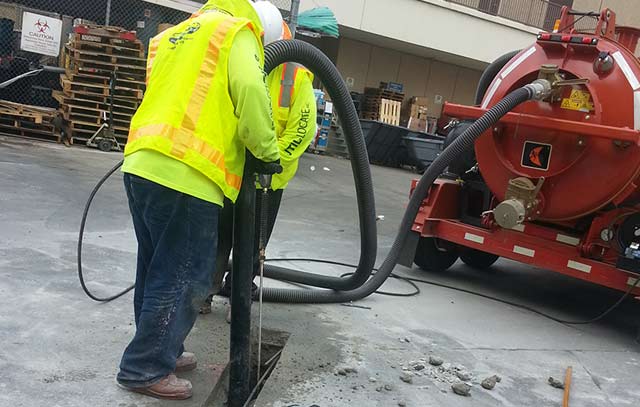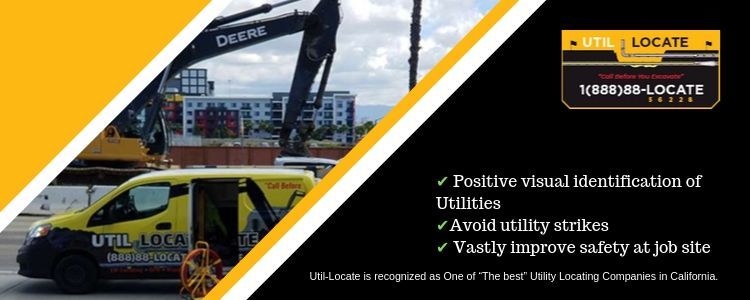Potholing for utilities is a method that construction site workers can use to obtain a wealth of visual information regarding piping and other subsurface construction. Utility potholing has increasing importance in the construction industry, as a method that can help to make excavation safer and more cost-effective to do.
In the past, it was commonplace for contractors to use a backhoe. This piece of equipment is highly recognizable to the general population as a typical piece of machinery you would find on a construction site. However, it does not have the precision or maneuverability of more modern excavation machinery, meaning it has the potential to cause immense damage to existing subsurface infrastructure.
Vacuum excavation is a process in which water is pushed through the earth creating a hole that allows the crew to visually confirm the location of the utility lines. As the earth is removed to create the hole, it goes into a special storage truck that can easily be removed from the construction site and dumped elsewhere.
Not only is potholing the most accurate way of learning the location of utility lines, but it is also time and cost-efficient. Keep reading to find out the many other benefits of using vacuum excavation on your construction site. Know more about pothole utilities.
Increased Safety using Vacuum Excavation
Nowadays, you are much more likely to find a vacuum excavator being used. These highly portable pieces of machinery use air to displace soil. Since the air and water are only vacuuming at low pressures, this means that other utilities in the ground will not be damaged, which makes vacuum excavation the preferred method compared to using a backhoe.
While vacuum excavation is an extremely safe process, there are still a number of precautions that should be taken to keep your crew and members of the public safe. Before utility potholing can take place, you should reach out to third parties who have knowledge of the construction site. They might be able to provide you with recent utility line maps or estimations for how deep the holes will need to be.
It is also always recommended that you hire an experienced team that specializes in vacuum excavation They will have the training and expertise necessary to do the job safely and efficiently. A professional team will also understand the importance of preliminary work such as using RADAR or digital technology to gather estimates for locations and depths.
By hiring specialists, you will minimize the risk of damage to the utility lines as well as the expensive excavation equipment. You will also save money by avoiding the possibility of a utility strike which can cause expensive repairs or fines if it affects the local community.
Vacuum excavation also has a wealth of other benefits compared to using a backhoe. When excavating, a backhoe will displace a considerably larger amount of soil compared to a vacuum excavator. A vacuum excavator simply stores the displaced soil inside the machinery, meaning there is no need for a dumping ground.
Increased cost efficiency using Vacuum Excavation
The next important benefit of using vacuum excavation, compared to backhoeing and manual labor, is the reduction in costs.
Manual digging is an outdated method of excavating that requires a significant number of man-hours to accomplish the same thing as backhoeing and vacuum excavation. In comparison, vacuum excavation would be much quicker while also causing much less disruption to the ground. Once work is complete, workmen would also have to refill the holes they had made, doubling the time taken.
Considering the amount of manpower required to excavate utility lines as well as the extended time frame to get the work done, relying on hand tools is a very costly option in the long run.
The cost implications for backhoeing are different from manual labor. This piece of machinery can be a great tool when displacing ground is clear of subsurface infrastructure. It can accomplish what multiple workmen would do in hours, in mere minutes. When used in an area containing subsurface infrastructure, the damage that can be caused by the metal bucket on a backhoe hitting existing piping and cabling could be disastrous. This would most likely result in the project being put on hold, whilst repairs to the infrastructure are completed by those who caused the damage. As you can see, the risks of using a backhoe are very real, meaning it is a good idea to consider using a vacuum excavator instead when potholing utilities. Know more potholing companies.
Summary
In summary, vacuum excavation is a new and improved method of potholing utilities.
A professional excavation team will understand the needs of your construction project and will also work diligently and efficiently. This means your crew and the land itself are kept protected throughout the excavation process.
The use of low-pressure water and air by this system means that existing subsurface infrastructure is less likely to get damaged, versus other methods such as backhoeing and manual digging. The cost savings and improvement to site safety can also be immense through this mitigation of risk. You can find out more information regarding vacuum excavation and potholing utilities by visiting Util-locate.com.


